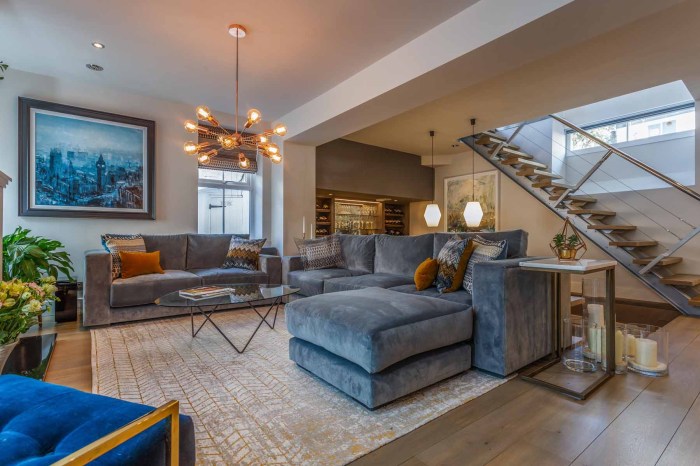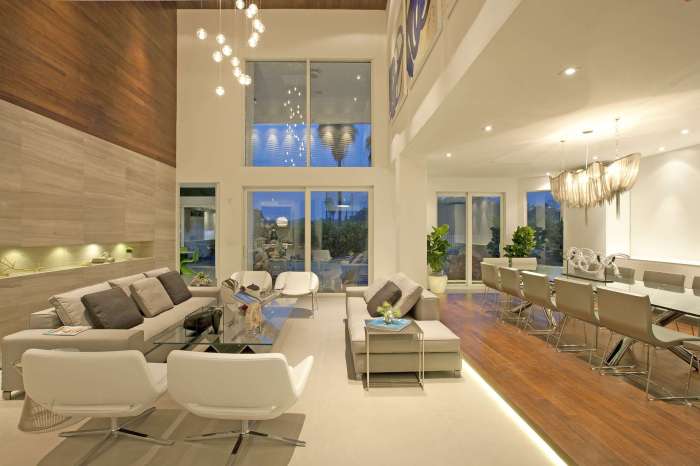Title: Enhancing Homes: Exploring the World of Residential Interior Design

Residential interior design is a captivating realm where creativity and functionality intersect to transform living spaces into personalized sanctuaries. From selecting the perfect color palette to optimizing spatial layouts, this field offers endless possibilities for creating homes that reflect individual style and comfort.
Let's delve into the art and science of residential interior design, uncovering key elements, principles, styles, and more that shape the ambiance of our living environments.
Introduction to Residential Interior Design
Residential interior design involves the planning and execution of interior spaces in homes to create a functional and aesthetically pleasing environment for the residents. It focuses on enhancing the overall quality of life within the home through thoughtful design choices and layouts.Interior design plays a crucial role in residential spaces as it has the power to transform a house into a home.
By carefully selecting colors, furniture, lighting, and accessories, interior designers can create a space that reflects the personalities and lifestyles of the residents while also ensuring functionality and comfort.
Differences Between Residential and Commercial Interior Design
Residential interior design differs from commercial interior design in several key ways. In residential design, the focus is on creating a personalized and intimate space that caters to the specific needs and preferences of the occupants. This often involves a more emotional and subjective approach to design, taking into account the individual tastes and lifestyles of the residents.On the other hand, commercial interior design is more focused on creating functional and efficient spaces that serve a specific business purpose.
The design decisions are based on the brand identity, target audience, and business objectives of the commercial space. This often involves a more systematic and strategic approach to design, prioritizing practicality and branding over personalization.
Elements of Residential Interior Design
When it comes to residential interior design, several key elements play a crucial role in creating a cohesive and visually appealing space. These elements include furniture, lighting, color schemes, decor, texture, and patterns.
Furniture
One of the fundamental elements of residential interior design is furniture. The choice of furniture pieces, their placement, and their style can significantly impact the overall look and feel of a room. Whether you opt for modern, traditional, or eclectic furniture, it should complement the space and enhance its functionality.
Lighting
Lighting is another essential element that can transform the ambiance of a room. Proper lighting can highlight architectural features, create a cozy atmosphere, and even affect the perceived size of a space. From natural light to artificial fixtures, the right lighting scheme can make a significant difference in a residential interior design.
Color Schemes and Decor
Color schemes and decor choices set the tone for a room and tie the design elements together. Whether you prefer a monochromatic palette for a minimalist look or bold, contrasting colors for a vibrant space, the color scheme and decor should reflect your style and personality.
Texture and Patterns
Texture and patterns add depth and visual interest to a room. Mixing different textures like smooth fabrics, rough wood, or shiny metals can create a dynamic and engaging space. Similarly, incorporating patterns through textiles, wallpapers, or artwork can add character and personality to the design.
Principles of Residential Interior Design
Residential interior design follows specific principles to create visually appealing and functional spaces. Let's delve into the key principles of balance, harmony, rhythm, emphasis, and proportion and how they are essential in designing residential interiors.
Balance
Balance in interior design refers to the equal distribution of visual weight in a space. It can be achieved through symmetrical or asymmetrical arrangements of furniture, colors, and accessories. For example, placing a large sofa on one side of the room can be balanced by a group of smaller chairs or a console table on the other side.
Harmony
Harmony is the coherence and unity among different elements in a room. It involves creating a sense of continuity and flow through color schemes, textures, and styles. An example of harmony is using a consistent color palette throughout the space to tie the design elements together seamlessly.
Rhythm
Rhythm in interior design creates movement and visual interest through patterns, repetition, and progression. It can be achieved by using repeated shapes, colors, or textures throughout the room. For instance, a striped rug, complemented by striped throw pillows and curtains, can create a rhythmic flow in a living room.
Emphasis
Emphasis highlights a focal point or a key element in a room to draw attention and create visual interest. This can be done through a statement piece of furniture, an accent wall, or a striking piece of artwork. For example, a bold, oversized chandelier in a dining room can serve as a focal point and add drama to the space.
Proportion
Proportion deals with the relationship between different elements in terms of size, scale, and proportion. It ensures that objects in a room relate well to each other and the space as a whole. An example of proportion is using appropriately sized furniture in a small room to avoid overwhelming the space and maintain balance.These principles of balance, harmony, rhythm, emphasis, and proportion are fundamental in creating well-designed residential interiors that are not only aesthetically pleasing but also functional and cohesive.
By understanding and applying these principles, interior designers can transform ordinary rooms into extraordinary spaces that reflect the homeowners' style and personality.
Styles in Residential Interior Design

When it comes to residential interior design, there are various styles that homeowners can choose from to create a space that reflects their personal taste and preferences. Some popular interior design styles include modern, traditional, minimalist, and eclectic.
Modern Style
The modern style is characterized by clean lines, minimalism, and a focus on function. Color schemes in modern design often feature neutral tones with pops of bold colors. Furniture choices typically include sleek and streamlined pieces that are both functional and stylish.
Traditional Style
In contrast, traditional style interior design is more ornate and classic, with a focus on intricate details and rich textures. Color schemes in traditional design tend to be warm and inviting, with a mix of patterns and prints
Minimalist Style
Minimalist style interior design is all about simplicity and decluttering. Color schemes in minimalist design are usually neutral and monochromatic, creating a sense of calm and tranquility. Furniture choices are often sleek and understated, with a focus on functionality and clean lines.
Eclectic Style
Eclectic style interior design is a mix of different styles, patterns, and textures. It allows homeowners to showcase their personality and creativity by combining elements from various design aesthetics. Color schemes and furniture choices in eclectic design can vary widely, creating a unique and personalized space.
Space Planning in Residential Interior Design

Effective space planning is crucial in residential interior design as it helps maximize functionality and enhance visual appeal. By carefully organizing and arranging furniture, fixtures, and other elements within a space, designers can create a harmonious and efficient layout that meets the needs and preferences of the inhabitants.
Optimizing Space in Small Residential Areas
When working with small residential areas, it is important to utilize every inch of space wisely to avoid a cramped and cluttered look. Here are some techniques for optimizing space:
- Choose multi-functional furniture pieces that serve more than one purpose, such as a storage ottoman or a sofa bed.
- Utilize vertical space by installing shelves or cabinets that reach up to the ceiling to maximize storage.
- Use light colors and mirrors to create an illusion of space and reflect natural light, making the room feel larger.
- Keep the area clutter-free by implementing smart storage solutions like hidden compartments or built-in organizers.
Creating an Efficient Flow in Open-Concept Living Spaces
Open-concept living spaces have become increasingly popular for their spacious and airy feel. To ensure a smooth flow and functionality in these areas, consider the following tips:
- Define different zones within the open space using area rugs, furniture arrangement, or architectural elements like columns or half walls.
- Allow for adequate circulation by leaving enough room for easy movement between furniture pieces and areas.
- Use consistent flooring materials and colors throughout the space to create visual continuity and a sense of cohesion.
- Consider the placement of lighting fixtures to illuminate various zones and create ambiance while maintaining a cohesive look.
Color Theory in Residential Interior Design
Understanding color theory is essential in residential interior design as it plays a crucial role in setting the mood and perception of a space. Different colors evoke different emotions and can greatly impact the overall feel of a room.
Psychology of Color
Color psychology is the study of how colors affect human behavior and emotions. For example, warm colors like reds, oranges, and yellows can create a cozy and inviting atmosphere, perfect for living rooms or dining areas. On the other hand, cool colors like blues and greens promote a sense of calm and relaxation, ideal for bedrooms or home offices.
Selecting the Right Color Palette
When choosing a color palette for different rooms, it's important to consider the function of the space. For instance, vibrant and energizing colors may work well in a kitchen or exercise room, while soft and soothing tones are more suitable for a bedroom or reading nook.
Harmonious color schemes create a sense of balance and unity in a room, while contrasting colors add visual interest and drama.
Examples of Color Combinations
- Monochromatic: Using varying shades of a single color for a sophisticated and cohesive look.
- Analogous: Combining colors that are next to each other on the color wheel for a harmonious feel.
- Complementary: Pairing colors that are opposite each other on the color wheel for a bold and dynamic contrast.
- Triadic: Selecting three colors that are evenly spaced on the color wheel for a vibrant and balanced scheme.
Summary
As we conclude our exploration of residential interior design, it becomes evident that every element, from furniture choices to color schemes, plays a crucial role in shaping the character of a home. By understanding the principles and techniques discussed, individuals can embark on a journey to revitalize their living spaces, infusing them with warmth, harmony, and personal flair.
Let your home tell a story of who you are through the artful lens of residential interior design.
FAQ Overview
How can I make a small room appear larger?
Opt for light color schemes, strategically place mirrors to create an illusion of space, and utilize multifunctional furniture to maximize functionality without overcrowding.
What are some popular interior design styles for homes?
Popular styles include modern, traditional, minimalist, and eclectic. Each style offers a unique aesthetic appeal and can be tailored to suit individual preferences.
Why is balance important in residential interior design?
Balance ensures that elements in a room are visually distributed harmoniously, creating a sense of equilibrium and visual appeal. It prevents spaces from feeling cluttered or overwhelming.
How do I choose the right color palette for my home?
Consider the function of each room and the mood you wish to evoke. Lighter shades can make spaces feel airy and spacious, while bold colors can add drama and personality.

